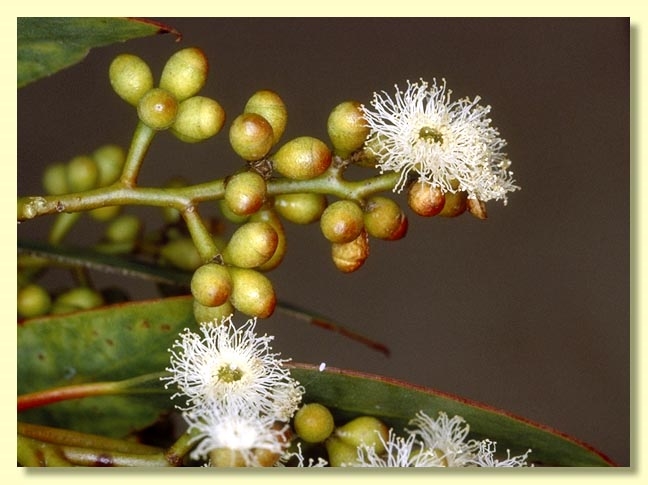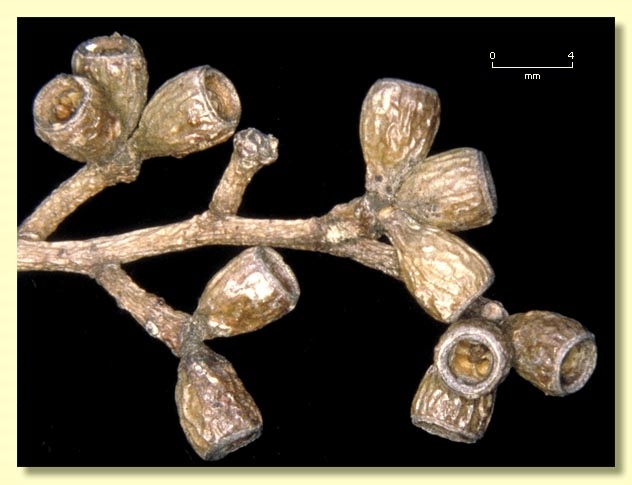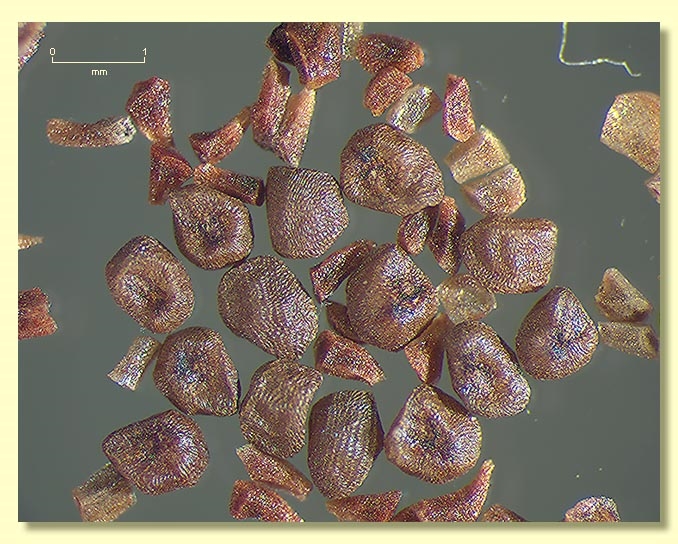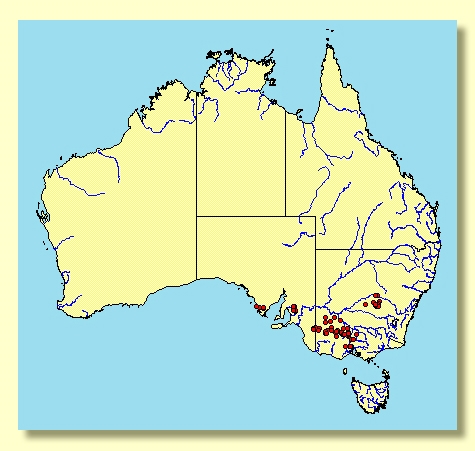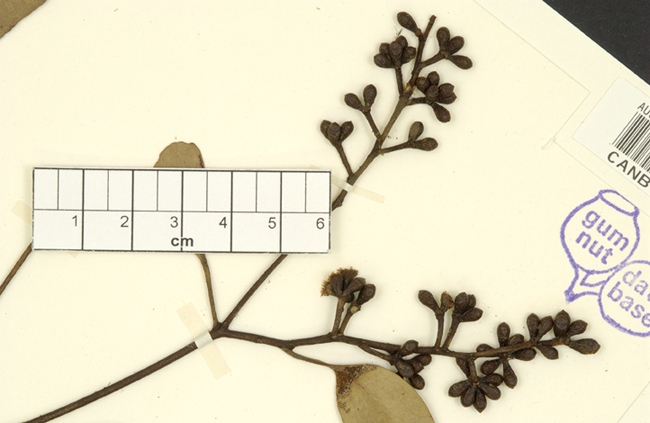Euclid - Online edition
Eucalyptus behriana
Eucalyptus | Symphyomyrtus | Adnataria | Apicales | Buxeales | Amissae
T: near Bacchus Marsh, Vic., Jan. 1853, F.Mueller s.n.; lecto: MEL 10388, fide J.H.Willis, Muelleria 1: 165 (1967); isolecto: CANB, K, MEL, NSW.
Bark on lower trunk rough, fibrous to box-type, dark brown to black, upper trunk and branches smooth, grey-brown to yellowish green or coppery, often with ribbons of decorticated bark on the branches.
Juvenile growth (coppice or field seedlings to 50 cm): stem rounded in cross-section; juvenile leaves alternate, petiolate, ovate, 5–10.5 cm long, 2.5–6.5 cm wide, usually green (glaucous only some restricted localities, see below).
Adult leaves alternate, petiole 1–2.2 cm long; blade broadly lanceolate to ovate, 4.5–13 cm long, 1.3–5 cm wide, base tapering to petiole or sometimes oblique, concolorous, glossy, green, side veins at an acute or wider angle to midrib, moderately to densely reticulate, intramarginal vein parallel to and well removed from margin, oil glands island and intersectional.
Inflorescence terminal compound (sometimes with a few axillary unbranched below it), peduncles 0.3–1 cm long, buds 7 per umbel, sessile or rarely on pedicels to 0.2 cm long. Mature buds obovoid to oblong, 0.3–0.7 cm long, 0.2–0.4 cm wide, green or red-brown, scar present (outer operculum shed during bud development), operculum conical to rounded, stamens irregularly flexed or inflexed, anthers adnate, globoid, dehiscing by broad lateral or subterminal pores, style short, stigma blunt, locules 3 or 4, the placentae each with 4 vertical ovule rows. Flowers white.
Fruit sessile or with pedicels to 0.2 cm long, cup-shaped or barrel-shaped, 0.3–0.6 cm long, 0.3–0.5 cm wide, disc level or descending, valves 3 or 4, near rim level or enclosed.
Seeds brown, 0.5–1 mm long, ovoid or flattened-ovoid, dorsal surface shallowly reticulate, hilum ventral.
Cultivated seedlings (measured at ca node 10): cotyledons reniform; stems rounded in cross-section; leaves always petiolate, opposite for ca 2 or 3 nodes then alternate, broadly ovate to broadly lanceolate, 4–8.5 cm long, 1.5–6.5 cm wide, dull, grey-green to bluish green (glaucous only in central NSW and at Bacchus Marsh).
Flowering has been recorded in January, February, April, May, July, October, November and December.
A mallee box of very disjunct distribution from lower Eyre Peninsula and the lower north of South Australia, north-west Victoria and near Bacchus Marsh, and the Wyalong and Ungarie district of central New South Wales. It has rough bark on the lower half of the stems, whilst the upper smooth bark is usually greenish or yellowish green. It has large, ovate juvenile leaves, glossy adult leaves and characteristically leafless terminal inflorescences of small, stubby, more or less sessile buds with an operculum scar. In some localities the juvenile leaves are conspicuously glaucous, e.g. Bacchus Marsh, Victoria and Wyalong and Ungarie, New South Wales.
Within its natural range E. behriana can be easily distinguished within mallee communities by the inflorescence features, dark box-type bark on lower trunk and smooth above, and stature—it is often taller than other mallees, hence the common name Bull Mallee.
Eucalyptus behriana belongs to Eucalyptus subgenus Symphyomyrtus section Adnataria (the boxes) because the buds have two opercula, ovules are in four rows, seeds are flattened-ovoid, cotyledons are more or less reniform and anthers are rigid on the staminal filaments. Within section Adnataria, E. behriana is part of a subgroup, series Buxeales, further distinguished by being partially rough-barked, having terminal inflorescences and buds that lose the outer operculum early. E. behriana and close relatives E. populnea in eastern Australia, and E. sparsa in Central Australia, have stamens irregularly arranged in bud and all fertile, and very glossy adult leaves. Two other related species occur in north-eastern Australia, E. brownii and E. cambageana, neither overlapping in distribution with E. sparsa and E. behriana.




